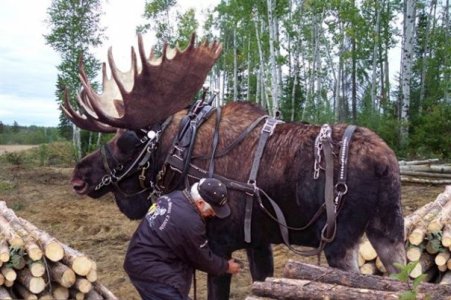You are using an out of date browser. It may not display this or other websites correctly.
You should upgrade or use an alternative browser.
You should upgrade or use an alternative browser.
redneck skidder
- Thread starter gotboost
- Start date
ponyboy
Active VIP Member
can you say ........... FO ..TO .. SHOP:d
polarice
Active VIP Member
hahahah:d
well at least ya could knock down the trees same time
goodngrubby
Active VIP Member
can you say ........... FO ..TO .. SHOP:d
I don't think so. My wife has an old black and white picture of her aunt and grandfather hitching up a plow to a moose in the sixties.
pipes
Active VIP Member
Antlers
The male's antlers grow as cylindrical beams projecting on each side of the head at right angles to the midline of the skull, and then fork. The lower prong of this fork may be either simple, or divided into two or three tines, with some flattening.
In the North Siberian elk (A. a. bedfordiae), the posterior division of the main fork divides into three tines, with no distinct flattening. In the common elk (A. a. alces) this branch usually expands into a broad palmation, with one large tine at the base, and a number of smaller snags on the free border. There is, however, a Scandinavian breed of the common elk in which the antlers are simpler, and recall those of the East Siberian animals.
The palmation appears to be more marked in North American moose (A. a. americanus) than in the typical Scandinavian elk.
Young female (A. a. americana) in Algonquin Park in early June
The male will drop its antlers after the mating season and conserve energy for the winter. A new set of antlers will then regrow in the spring. Antlers take three to five months to fully develop, making them one of the fastest growing animal organs. They initially have a layer of skin, called "velvet," which is shed once the antlers become fully grown. Immature bulls may not shed their antlers for the winter, but retain them until the following spring.
If a bull moose is castrated, either by accidental or chemical means, he will quickly shed his current set of antlers and then immediately begin to grow a new set of misshapen and deformed antlers that he will wear the rest of his life without ever shedding again. The distinctive looking appendages (often referred to as "devil's antlers") are the source of several myths and legends among many groups of Inuit as well as several other tribes of indigenous peoples of North America.[27]
In extremely rare circumstances a cow moose may grow antlers. This is usually attributed to a hormone imbalance.[28]
I'm gonna side with ponyboy
The male's antlers grow as cylindrical beams projecting on each side of the head at right angles to the midline of the skull, and then fork. The lower prong of this fork may be either simple, or divided into two or three tines, with some flattening.
In the North Siberian elk (A. a. bedfordiae), the posterior division of the main fork divides into three tines, with no distinct flattening. In the common elk (A. a. alces) this branch usually expands into a broad palmation, with one large tine at the base, and a number of smaller snags on the free border. There is, however, a Scandinavian breed of the common elk in which the antlers are simpler, and recall those of the East Siberian animals.
The palmation appears to be more marked in North American moose (A. a. americanus) than in the typical Scandinavian elk.
Young female (A. a. americana) in Algonquin Park in early June
The male will drop its antlers after the mating season and conserve energy for the winter. A new set of antlers will then regrow in the spring. Antlers take three to five months to fully develop, making them one of the fastest growing animal organs. They initially have a layer of skin, called "velvet," which is shed once the antlers become fully grown. Immature bulls may not shed their antlers for the winter, but retain them until the following spring.
If a bull moose is castrated, either by accidental or chemical means, he will quickly shed his current set of antlers and then immediately begin to grow a new set of misshapen and deformed antlers that he will wear the rest of his life without ever shedding again. The distinctive looking appendages (often referred to as "devil's antlers") are the source of several myths and legends among many groups of Inuit as well as several other tribes of indigenous peoples of North America.[27]
In extremely rare circumstances a cow moose may grow antlers. This is usually attributed to a hormone imbalance.[28]
I'm gonna side with ponyboy
can you say ........... FO ..TO .. SHOP:d
What part would/could be shopped ?
- Thread starter
- #7
gotboost
Active VIP Member
i heard the old timers talking around here and they said the seen people that had swamp donkeys aka moose trained as pack horses :d
pipes
Active VIP Member
i heard the old timers talking around here and they said the seen people that had swamp donkeys aka moose trained as pack horses :d
that may very well be true. but think about it. check out the picture and read the clip from Wikipedia that I posted
Luke The Drifter
Active VIP Member
Similar threads
- Replies
- 14
- Views
- 2K
- Replies
- 12
- Views
- 896





